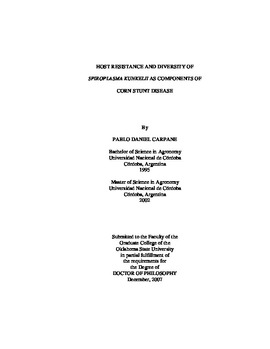| dc.contributor.advisor | Fletcher, Jacqueline | |
| dc.contributor.author | Carpane, Pablo Daniel | |
| dc.date.accessioned | 2013-11-26T08:23:44Z | |
| dc.date.available | 2013-11-26T08:23:44Z | |
| dc.date.issued | 2007-12 | |
| dc.identifier.uri | https://hdl.handle.net/11244/6730 | |
| dc.description.abstract | Corn stunt is an important plant disease for which successful control using resistant maize germplasm has been unsatisfactory in the past. It is unknown at present if the pathogen Spiroplasma kunkelii has the ability to generate a variety of pathotypes able to breakdown maize resistance, or whether the insect vector Dalbulus maidis plays a role in detecting components of such resistance. In this study, we sought to characterize these important components in this pathosystem, providing information useful to the design of strategies of disease control. | |
| dc.description.abstract | Findings and Conclusions: | |
| dc.description.abstract | Field-resistance to corn stunt was not completely correlated to parameters of resistance to insects, in tests performed in controlled conditions. An antixenotic response against D. maidis was not found, although one resistant hybrid exhibited antibiosis as decreased nymphal survival and adult longevity. Inoculation efficiency was similar for all the genotypes evaluated, whether resistant or susceptible, indicating that resistance mechanisms would not prevent pathogen transmission once inoculative insects settled on the plant. | |
| dc.description.abstract | The electrical penetration graph (EPG) technology was also used to characterize maize resistance. Six distinct waveforms were characterized and correlated with major probing activities of D. maidis by monitoring transmission of spiroplasmas and excretion of honeydew. The probing behavior of D. maidis was somewhat altered by the resistance level of the plant genotype. Insects probing in resistant hybrids salivated for longer periods of time before ingesting from phloem, and displayed increased xylem ingestion. However, phloem ingestion was not prevented in resistant hybrids. | |
| dc.description.abstract | S. kunkelii has minimal polymorphism, and a similar level of variability in different geographical locations. Strain variation was in part due to viral insertions, and in part to differences in a gene encoding a membrane protein implicated in attachment to insect cells. The results suggest that it is unlikely that instability of maize resistance is due to generation of new pathotypes of S. kunkelii. Instead, other components of this complex pathosystem could account for the breakdown of resistance. | |
| dc.format | application/pdf | |
| dc.language | en_US | |
| dc.rights | Copyright is held by the author who has granted the Oklahoma State University Library the non-exclusive right to share this material in its institutional repository. Contact Digital Library Services at lib-dls@okstate.edu or 405-744-9161 for the permission policy on the use, reproduction or distribution of this material. | |
| dc.title | Host resistance and diversity of Spiroplasma kunkelii as components of corn stunt disease | |
| dc.contributor.committeeMember | Melcher, Ulrich | |
| dc.contributor.committeeMember | Hunger, Robert | |
| dc.contributor.committeeMember | Wayadande, Astri | |
| osu.filename | Carpane_okstate_0664D_2564.pdf | |
| osu.accesstype | Open Access | |
| dc.type.genre | Dissertation | |
| dc.type.material | Text | |
| dc.subject.keywords | maize | |
| dc.subject.keywords | corn stunt | |
| dc.subject.keywords | spiroplasma | |
| dc.subject.keywords | dalbulus | |
| dc.subject.keywords | leafhopper | |
| dc.subject.keywords | resistance | |
| thesis.degree.discipline | Plant Pathology | |
| thesis.degree.grantor | Oklahoma State University | |
